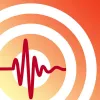Take a look inside 5 images
QuakeFeed Earthquake Alerts
Pros: Free, real-time earthquake data and alerts with plenty of map and filter options.
Cons: Lack of user instructions or tutorials could frustrate beginners.
Bottom Line: This free reference tool great for tracking earthquakes and identifying potential patterns of activity.
There's plenty of potential for use in the classroom here, but you'll have to do some legwork. It would be a great supplement to Earth science lessons about plate tectonics. Once kids have learned about the general concept of plate tectonics and the types of plate boundaries, create a class data chart and work together to track and record global earthquakes each day. Be sure to note in the data chart the types of boundaries along which the earthquakes occur, as well as the earthquake magnitudes. If any occur in your area, discuss those in more detail, relating the locations to any topography or landforms that students may be familiar with. It might be more manageable if you set the app to only map earthquakes with a magnitude of 4.0+, although it could be interesting to spend a class period observing and discussing just how many "small" earthquakes occur in the world each day. Once you have tracked at least a week's worth of data, have students work in small groups to analyze and summarize the results, and then discuss the data as a class.
QuakeFeed Earthquake Alerts is a well-done reference tool that can be used to teach kids about the causes and patterns of earthquakes and the importance of tracking and warning the public about potentially dangerous events. Kids can tap to access a list that includes magnitude, location, date, and time of earthquakes dating as far back as 30 days. When kids tap on an icon for a particular earthquake on the list, the app automatically zooms into that location on the map. The list can be sorted by date, magnitude, distance, or depth, or filtered by magnitude. Kids can choose from seven different base maps, such as topographic, satellite, shaded relief, bathymetric maps and more. Kids can also choose different map styles by using magnitude markers or circle, and by turning the plate lines on and off. Notifications for magnitude 6.0+ earthquakes worldwide are included in the free version of the app, and custom notifications are available for in-app purchase.
Kids can track earthquake activity across the globe with QuakeFeed Earthquake Alerts. With numerous map style and layer options, kids can learn about the relationship between earthquakes, magnitude, and plate boundaries. For example, turning on the plate lines helps kids see patterns of activity along convergent, divergent, and transform plate boundaries. Using different map styles can also help kids understand the connection between earthquakes and land or ocean features. For instance, when using the ocean bathymetry map, kids can observe earthquake activity along ocean ridges, which are colored in a light shade of blue on the map. A news feed adds to the learning experience with current information about earthquakes and map interpretations, as well as links to interesting scientific articles.













